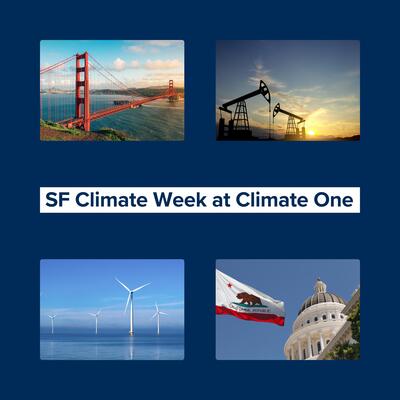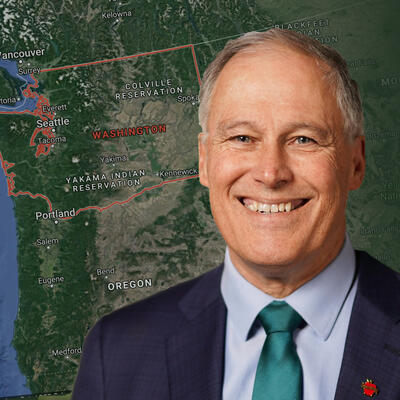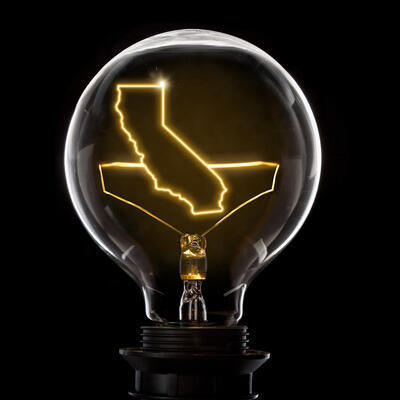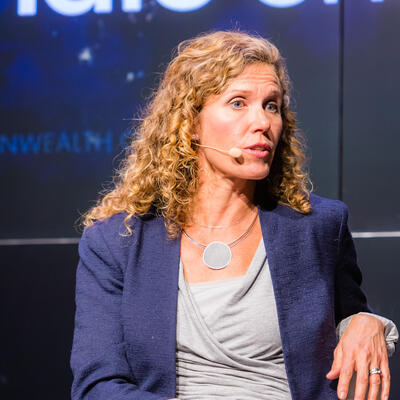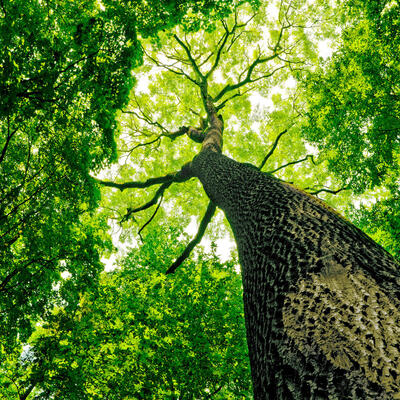
Clearing the Air on Carbon Offsets
Guests

Lisa Song
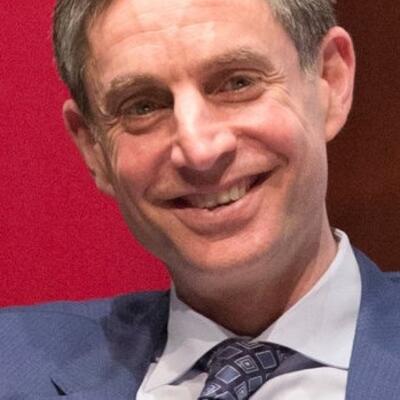
Michael Greenstone
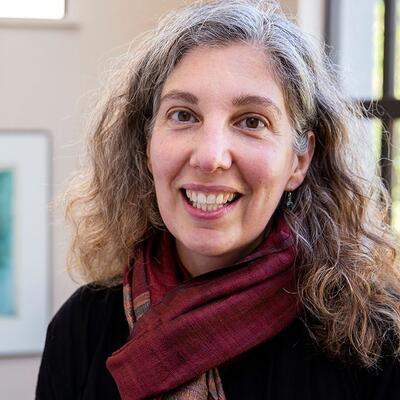
Barbara Haya
Summary
For more than two decades, carbon offset programs have promised individuals and businesses that they can reduce their overall carbon footprint by paying someone else - somewhere else - to reduce their emissions. But in practice this often doesn’t accomplish the intended climate benefit.
In a series of stories earlier this year, ProPublica reporter Lisa Song detailed how one carbon offset program in California failed to deliver on its climate goals, and actually resulted in more carbon emissions being released into the atmosphere.
“Basically, it comes down to the rules as they were written,” says Song. Her reporting covered a study by the nonprofit group CarbonPlan that showed that the forest carbon offset program designed by the California Air Resources Board allowed people to take advantage of how the carbon storage potential was measured for different forest types.
“They found a pattern where people are choosing to place offset projects in forests with very carbon-rich trees where the types of trees in their forest don’t resemble the types of trees that went into calculating the regional average,” Song says, which had the effect of generating tens of millions of “ghost” credits that don’t achieve real climate benefits. This matters because people around the country and world look to California as a model when it comes to cap and trade and carbon offset programs, she says.
“And therefore if people are just following these rules without really scrutinizing them then you run the risk of exporting these flaws to other states and countries,” Song says.
Barbara Haya, director of the Berkeley Carbon Trading Project at University of California Berkeley, says such flaws are common among many of the carbon offset programs that have come about in the last two decades.
“The problems are really built into the structure of the market,” she says. “We really know how to measure emissions. It's much harder to measure emissions reductions.”
“Offsets are presented as verified quantified tons of emissions reductions and they aren't that, because of the uncertainty,” Haya says. Instead, she says, we should first work to reduce our own emissions and then view offsets as a way to support climate projects that accomplish some degree of emissions reductions. “And in that context, we can really think about offsets, the way they truly are today, as a charitable contribution.”
Michael Greenstone, an economist at the University of Chicago, has a different view: “If there were a reliable offset that was inexpensive, I don't think people should be embarrassed to live whatever life they want to live and then just offset it. But the critical thing is that it be done in a reliable and transparent way,” he says.
He’s launched a new nonprofit called Climate Vault that aims to accomplish that by buying emissions permits from regulated markets and locking them away so other polluters can’t buy and use them, a process he terms pressing “the easy button,” because it relies on enforcement though existing government-mandated carbon markets.
“If you're looking for bang for the buck, that is, as much carbon reduction as possible for every dollar you spend, that’s the exact purpose of those markets,” Greenstone says.
Once they acquire a sufficient number, Climate Vault says it will use those carbon permits to launch the “world’s first large-scale ecosystem for carbon removal,” he says, trading the permits ton for ton for proven carbon dioxide removal from the atmosphere.
Related Links:
The Climate Solution Actually Adding Millions of Tons of CO2 Into the Atmosphere
Climate Vault
Berkeley Carbon Trading Project
Full Transcript
Greg Dalton: Is there a better way to regulate and use carbon offsets? Climate One’s empowering conversations connect all aspects of the climate emergency. I’m Greg Dalton. For more than two decades, carbon offset programs have promised individuals and businesses that they can reduce their overall carbon footprint by paying someone else - somewhere else - to reduce their emissions. But in practice this often doesn’t accomplish the intended climate benefit.
Lisa Song is a reporter for ProPublica who covers the environment, energy and climate change. In a series of stories earlier this year, she detailed how one specific forest carbon offset program in California failed to deliver on its climate goals, and actually resulted in MORE carbon emissions being released into the atmosphere. Later in the show, we’ll explore some possible ways to improve the system. First, though, Climate One Producer Ariana Brocious speaks with Lisa Song about her reporting.
Ariana Brocious: Can we start with some basics here for people who maybe don't understand the nitty-gritty of carbon offsets. How do carbon offsets work at the most basic level?
Lisa Song: Basically, carbon offsets are about paying somebody else somewhere in the world to reduce their carbon emissions and then claiming those reduced emissions as your own. One of the things about climate change is that no matter where the carbon emissions come from they all end up in the same atmosphere and all help fuel climate change. So, if you are a company somewhere that perhaps would need to spend a lot of money to reduce your own emissions, if the government allows it you could spend less money and pay someone somewhere else to reduce their emissions.
Ariana Brocious: And so, do those work the same if say I take a flight and I want to offset the carbon footprint of my trip, is that the same as a company who wants to pollute more, or maybe is limited in how much they can pollute or burn fossil fuels in this case and buys an offset for that purpose.
Lisa Song: They are similar in the sense that it's all about paying someone else to reduce emissions but if you are someone who is flying and wants to offset your own emissions you are likely buying carbon offsets from what's called the voluntary marketplace. That means you're buying emissions reductions that help you feel better but they are not being accounted for in some sort of government mandated climate program. Whereas what's happening in places like California is they have a government mandated climate goal and they are counting every ton of CO2 that goes into the air and those carbon offsets in California are part of this mandatory emissions reductions program. So, in the compliance market if you are a major polluter the government has regulations that force you to reduce your emissions by a certain amount.
Ariana Brocious: And so, in either case, I'm kind of curious why so many of the carbon offset programs that are available take the form of protecting land like forest that already exists as opposed to things like planting new forest or other kinds of carbon absorbing tools that we may have.
Lisa Song: Yeah, that's a good question. I think part of the answer has to do with that there is a huge push for good reason for conservation and for biodiversity. And there is no doubt that we need to preserve the existing forest we have, particularly a lot of tropical forests and rainforests in order to help meet our climate goals. Protecting forests is definitely good for the environment and for climate change, and I think in some ways by emphasizing these forest protection-based carbon offsets you are allowing people to fulfill two goals at once. The first one is reducing emissions in the atmosphere and the second one is forest conservation. The problem of course is that we are documenting cases where these programs aren’t working as advertised.
Ariana Brocious: Right. And I want to get into that in just a second. Part of the rationale for using existing forest also might be just that they’re already a big carbon sink, right, and the loss of them would sort of further exacerbate the situation we’re in.
Lisa Song: Right. So, forests and particular the forests that have a lot of carbon rich tree species bigger trees that can store a lot of carbon they've been pulling down CO2 from the atmosphere for decades if not centuries. And if you were to cut down those forests because you need lumber or because you need to clear the forest to graze cattle or something, then you are releasing into the atmosphere, a huge amount of stored carbon that's been stored for decades. And so, the idea with these offsets is you pay people to preserve their forests and keep the trees standing instead of cutting them down and then you give them credit for preventing those emissions.
Ariana Brocious: And how do those programs, the carbon offsets fit in with larger cap and trade programs like California's cap and trade program?
Lisa Song: There are different ways that you can fit a carbon offset program into cap and trade. But in California the way it works is that companies have to reduce their emissions by a certain amount every year. And one way they can do that is through cap and trade where they can buy excess permits for emissions from other companies that don't need them or they can buy them from the state at auction. Some companies also receive those emissions permits for free and of course there's the trade part where if you have excess permits you can sell it to another polluter. But the state also gives them an option where they can reduce a certain amount of their emissions by buying carbon offsets instead. And so, the state of California through the Air Resources Board has set up this carbon offset program where they are encouraging every day landowners in the country to enroll their forests in carbon offsets and then those offsets generated can be purchased by the polluters that are regulated under the cap and trade program.
Ariana Brocious: And your reporting for ProPublica has revealed that that program California's carbon offset forest program has actually allowed a lot more carbon to be released into the atmosphere, right. Why is that?
Lisa Song: Basically, it comes down to the rules as they were written. Our story was reporting on a study that came out of a nonprofit and basically, the study showed that when the Air Resources Board wrote up the rules for the carbon offset program the way they set up the rules sort of opened up these loopholes that allowed the system to be gamed. So, what the study shows is not that anybody is breaking the rules, but actually that there are systemic flaws built into the rules themselves.
The technical flaws are pretty complicated but basically once you've picked the forest that will be enrolled in the offsets program you would do a survey of the trees in that forest to figure out how much carbon is stored per acre in your forest. Then what you do is you compare that number to the amount of carbon stored in a typical forest of a similar type as your forest. And these typical forest numbers are called regional averages and they're all calculated and established by the Air Resources Board. The problem is that these regional averages have been calculated using course data that doesn't take into account a lot of the nuances between different types of trees and different types of tree species. And what the Carbon Plan scientists discovered was they found a pattern where people are choosing to place offset projects i n forests with very carbon rich trees where the types of trees in their forest don’t resemble the types of trees that went into calculating the regional average. And it's this skewing of the types of forests and the skewing of the difference that ends up inflating the carbon savings you're generating.
Ariana Brocious: So, just to kind of recapture what you said. How did that then result in there being more carbon emissions being released when the actual goal is to reduce them or limit them?
Lisa Song: Right. Because every time a company buys carbon offsets, you know, let's say a company, a polluter in California needs to reduce their emissions by 5 million tons that year, and they buy 5 million carbon credits that then gives them the right to emit 5 million tons of CO2. So, the polluters emissions of CO2 are real. All those 5 million tons, even if the 5 million carbon credits they purchased are not all real. So, you end up you know if the system works perfectly then every carbon credit cancels out a real ton of CO2 that is emitted. And when the system doesn't work perfectly every carbon offset that is not real you are not balancing out the real emissions and so you end up with a net increase in CO2 emissions.
Ariana Brocious: Right. Okay. So, I think there's some proponents of carbon offsets who would say that it’s an inexact science right and that there's going to be some loss or it's not gonna be precise in every case. But there are cases where those landowners may not have even been planning to log their forest, right?
Lisa Song: Yes. And that’s a separate issue. On the carbon accounting regional averages issue which was the focus of the carbon plan study, they found that overall, those flaws created up to 39 million carbon credits that aren’t achieving real carbon savings. Separately, the study also pointed to the fact that one of the biggest questions we always have with carbon offsets is a carbon offset is only real if you're saving trees that would otherwise have been cut down because if the landowner was never going to log the trees then they were never in danger and those emissions never would've been emitted anyway. And it's a very difficult thing to prove what somebody would have done if the carbon offsets didn't exist. So, this is a perpetual problem in assessing offset programs. And in California what we were able to find was that there are certain cases, such as with the Massachusetts Audubon Society where it's what the society said in their paperwork was that they would have or they could have cut down a ton of their trees to a level that wasn't very realistic for a conservation group. And so, that showed this other weakness in the program is that it's unclear how many of the carbon offsets are not real because the landowner would not have realistically cut down those trees.
The reason why the California program is so important is that a lot of people not just in the US but around the world look at California's cap and trade program as an example of something that really works and as one of the best carbon reduction systems in the world. And therefore if people are just following these rules without really scrutinizing them then you run the risk of exporting these flaws to other states and countries.
Ariana Brocious: I'm speaking with Lisa Song, a reporter at ProPublica covering the environment, energy and climate change. And we should note that the California Air Resources Board, who, as you said, designed this program objects to some of your findings. What is their critique and how did you respond?
Lisa Song: Their critique is that their program is legit and they don't agree with the flaws that the study authors pointed out. I will say that we did give them a full chance to respond weeks before we publish the story we sent them the complete study and its detailed methodology. They didn't really comment on the specifics of the study itself or its methods. We also took pains to try and really talk to them and offered to talk on the phone starting months before we published and they refuse to give us a single phone interview.
Ariana Brocious: So, based on your reporting what would be ways to improve this program or this kind of a program and avoid some of that over crediting that's been occurring?
Lisa Song: Really the key way to solve this is to recalculate those regional averages that are so important to figuring out carbon credits. And the carbon plan scientists in their paper offer one way of recalculating those regional averages. What they basically did was for every project in the program they calculated what they believe is a more accurate version of the regional average by using data from tree species that more closely resemble the actual mix of trees in the project itself.
Ariana Brocious: So, there's a roadmap if the California Air Resources Board wanted to look into that.
Lisa Song: Yes, yes, there is. And, you know, the carbon plan folks have offered their very exact version of the calculations and explained how they did it. There are undoubtedly other methods that you could recalculate the regional averages and those would be very detailed scientific decisions and methods to discuss and it is in the power of the Air Resources Board to figure that out and see if they want to do some version of that.
Ariana Brocious: So, another aspect of your reporting I found interesting is that tribes have kind of a mixed experience with this program. Can you explain some of the tribes that have participated and what those mixed experiences have been?
Lisa Song: Sure. So, one of the tribes is the Yurok Tribe in California and they have participated in at least two different carbon offset projects on their land. They have gained a lot of money from these programs and they have use some of that money to help buy back some of their ancestral lands and some of that money, you know, has gone to various cultural programs as well. I interviewed someone from a different tribe the Hoopa Valley Tribe where at least so far, the tribe is not inclined to participate in carbon offsets. They don't like the idea of giving somebody else the right to emit more CO2. So, there's obviously mixed feelings and mixed opinions among different tribes on whether they want to participate. And another thing we want to be clear on is that you can have great conservation benefits and cultural and economic benefits from the programs even if the CO2 savings are less than what was promised. And one of the key questions is are we willing to accept these flaws in the carbon math if it means we are getting these benefits in conservation. But can we even make that decision if we don't know for sure what percentage of the offsets are real.
Ariana Brocious: Lisa Song, thanks for joining us here on Climate One.
Lisa Song: Thanks for having me.
Greg Dalton: You’re listening to a Climate One conversation about reexamining carbon offsets. If you missed a previous episode, or want to hear more of Climate One’s empowering conversations, subscribe to our podcast wherever you get your pods. Coming up, we dig into why many current carbon offsets don’t work:
Barbara Haya: Measuring emissions reductions from offsets is inherently uncertain and that uncertainty means that there's wiggle room in interpreting quality. So, when that uncertainty meets this industry that’s stacked against quality it’s very hard to pull it back and get high-quality results. That’s up next, when Climate One continues.
Greg Dalton: This is Climate One. I’m Greg Dalton, and we’re talking about rethinking carbon offsets. Barbara Haya is director of the Carbon Trading Project at the University of California Berkeley. Michael Greenstone is Milton Friedman Distinguished Service Professor of Economics at the University of Chicago and founder of the new nonprofit, Climate Vault, which aims to fix some of the problems with carbon offsets we heard about earlier with Lisa Song.
Voluntary carbon offsets are widely available - for example, for individuals buying airplane tickets and for businesses eager to look “green.” In some places, customers filling up their gas tanks see a notice saying the entire emissions of that fuel are offset by funding forest programs far away. The driver pays a small additional price to feel good about negating their climate impact. I asked Michael Greenstone if offsets like that work as advertised.
Michael Greenstone: Well, it's a terrific idea. And I think it's starting point is frustration that people have, that government policy is not addressing the climate crisis in the way that is merited. And in the absence of like robust government policy, people want to do something about their climate footprint. And being able to offset your emissions at the fuel pump is a terrific idea. It allows people to participate. The challenge has been that these products or offsets have been available for about a quarter of a century. And, you know, every year there's a “new scandal” indicating that the offsets are failing to deliver the carbon reduction. And at some point you begin to ask yourself is it actually a “new scandal.”
Greg Dalton: Is it structurally built into these things that are inherently flawed. So, what do you think is this, you know, do you trust carbon markets?
Michael Greenstone: Well so, I think we should be specific. I trust compliance markets which are markets and upper governments to restrict CO2 emissions. I think these voluntary offset markets have a really checkered past and you know the story line is kind of a mañana line, tomorrow we’re gonna get this right. And I think after 25 years it’s time to find a way for people to be able to express their desire and organizations for that matter to reduce their carbon footprint. And I think we should stop, you know, it’s only insane if you keep doing the same thing when it doesn't work over and over and we should look for a new approach.
Greg Dalton: So, there's two more because there’s the compliance markets which are required companies, power plants, etc. required to reduce measure and reduce their carbon emissions. And then there’s the voluntary markets, which is you and me wanna offset a flight or our driving and that's the market Michael you're saying is problematic. Barbara, when governments and companies started designing ways to cut carbon pollution, they naturally wanted to do that at the lowest cost. They could do that directly by cleaning up smokestacks and tailpipes or indirectly by building clean energy or preserving forest somewhere else. Is that misguided is that the right way to go about it?
Barbara Haya: So, I mean I agree very much with Michael that it's a compelling idea that isn't working and hasn't worked and hasn't worked for 20, 25 years. And I’ve thought a lot about why it hasn't worked for over two decades and I think the problems are really built into the structure of the market. So basically what I see is that we really know how to measure emissions. It's much harder to measure emissions reductions. There’s a lot more uncertainty in measuring emissions reductions because you have to measure them against what would likely have happened without the carbon finance without the offset income.
Greg Dalton: That’s called additionality or additive, right, that’s the key thing, right.
Barbara Haya: Yeah. So, one of the key issues is when offset, you know, when a forest land owner participates and claims that they would have clear-cut their forest where if not for the offset income would they really have done with that the wind power developer did they really need that offset income to go forward. And there’ve been real problems with the offset industry allowing in a wide range of projects, many of which would've happened anyway. That's one problem. The other problem is when you're measuring emissions against what would likely have happened anyway there’s also the question of, even if the project really is “additional” if it really did need the offset income what is that scenario, what would likely have happened otherwise. That's also a key uncertainty.
Michael Greenstone: Can I just jump in here for a second, Greg? I agree with everything Barbara is saying. And let me just add one more thing as, you know, maybe the cynical economist here. Nobody really has incentives to get it right, who's at the table. The parties at the table are basically Greg Dalton who wants to offset his emissions when he is filling up his gas tank. He wants to feel good about that.
Greg Dalton: Well, I drive electric cars. I don't have a gas tank. But someone else, yes.
Michael Greenstone: Okay, someone else. The forestry project, the guy who runs the forestry project he’s at the table too. He sure would like some money and as Barbara just described he can basically say anything about what he was going to do in some alternate world. And then sometimes and often then there’s like a middleman in between. Think of them as like a consultant. That consultant is probably getting paid by both sides at least and their job at some level to kind of produce projects. And so, everyone is kind of in on the deal on the transaction like Greg Dalton who had a gas car maybe in some point in the past. The consultant is in on the deal and the forestry persons are on the deal. Now, who’s missing who’s not at the table? The entity who’s not at the table is the planet. And what is the planet care about they only care about the emissions CO2. They don’t care that Greg feels good about also his emissions. They don’t care that the forestry guy got a little extra money for saying that he would have cut down these trees. And they don’t care that the consultant got some money. Like the planet only cares about emissions and yet they’re not at the table. And so, given that confluence of incentives I think it's not terribly surprising when combined with Barbara's good point about how difficult it is to measure avoided emissions. It’s not very surprising that we’re getting the results for 25 years that we’ve been getting.
Greg Dalton: There’s another person missing. The last time Barbara and I talked couple years ago the episode included Pauline Kalunda, Executive Director of ECOTRUST Uganda. She said, the way people in developing countries approach carbon offsets is actually from the adaptation perspective. We live at the frontline and are affected by climate change. So, from a developed country it comes as your offsetting your footprint. In the developing countries it comes as I'm building my resilience. So, there’s another piece there’s another person at that table, which is some of the developing countries who receives capital money from rich countries to help them fight climate change is that a bad thing, Barbara?
Barbara Haya: No, it isn’t. Okay, so first thing can I just follow up really quickly in what Michael said. I totally agree with everything that you just said and just to pull it all together. Measuring emissions reductions from offsets is inherently uncertain and that uncertainty means that there's wiggle room in interpreting quality. So, when that uncertainty meets this industry that stacked against quality it’s very hard to pull it back and get high-quality results.
Greg Dalton: So, it’s imperfect information in the marketplace.
Michael Greenstone: But Greg, you’ve raised another really important issue. Hey wait, oftentimes there are some other goal that might be to build climate resiliency in sub-Saharan Africa. It might be, any of a myriad of other goals and often those goals are very laudable and hard to be against in fact easy to before. I think the challenge is, though we are at a incredibly urgent moment with the climate crisis. And my view is that we have to be like a laser on tons, tons, tons that is tons of CO2. And once you start admitting that there are projects that have multiple goals. Again, the planet is not at the table. The planet really just wants fewer tons of CO2. And I think when you have multiple goals and flexibility in measurements, like it should not be surprising that we’re getting the result we’re getting.
Greg Dalton: Right. Well, I’m actually interested, you know, I read a report recently that came out from your institute, Michael, and it’s the US Energy & Climate Roadmap. And I frankly was surprised to see in the second paragraph reference to Jim Crow and persistent racial and income disparities in our country. I honestly did not expect that so prominently from University of Chicago report notice of bastion of conservatism. But that gets to, you know --
Michael Greenstone: Wait, hold on, Greg. Hold on let me object to that like bastion of conservatism is not the same thing as racism.
Greg Dalton: Okay.
Michael Greenstone: I would say that they’re like a thousand miles apart.
Greg Dalton: Okay. Some people might question that. But would that have happened before America’s unfolding racial reckoning and what I’m getting out here is that, you know, that report said there’s another --
Michael Greenstone: We’re getting a little further here like the bastion of conservatism is belief in the use of markets to help solve social problems and grow incomes and things like that. That doesn't mean taking, you know, that is not the same thing it’s very decidedly not the same thing as discrimination it’s decidedly not the same thing as subjugation of people based on their race or a variety of other you know morally repugnant things that you phrased.
Greg Dalton: Right. I guess some people would say that American capitalism was initially founded on slave labor so that sort of, you know, racism is deeply rooted.
Michael Greenstone: That’s fine but that’s like a very different thing than talking about like economic advice. You would not find a single economist at the University of Chicago who is advocating for forced labor or slavery or anything like that. That's a conflation that --
Greg Dalton: Okay, fair enough. So, we’re talking about offsets and offsets there are some dimension of offsets which is directing money toward people who’ve been disadvantage. Whether it's in poor countries or in poor neighborhoods. And one of the criticisms of offsets is that it, you know, so there’s a generation of capital and money flow here that some people want to address either current harms or past harms. And I think your report gets at that and is that a useful part of offsets if it helps generates money. In California there’s a carbon market 35% of the money is supposed to go toward disadvantaged communities. And one of the criticisms of offsets is that it allows people to clean up another country, but they don't clean up their backyard.
Michael Greenstone: Yeah, so there’s a mix of issues there, I think. There are a series of laudable environmental justice goals out there and I think the question I am focused on is can we achieve those that’s critically important too, but is it necessary to compromise the goals for confronting the climate crisis. And that it boils down to reducing tons of CO2 and that’s what offsets are supposed to offer. And what I've been trying to say is it for the last quarter-century they have had a very checkered record on that. And if you want to achieve multiple goals, that’s fine there’s nothing wrong with that. But then you should acknowledge from the start this is not really about reducing tons of CO2, this is not undoing, you know, the person who wants to undo filling up their gas tank of the car. It’s maybe achieving other goals, those goals could be critical and urgent social goals but in terms of what the planet cares about tons, tons, tons, they are not hitting the mark.
Greg Dalton: Barbara, how do you see that environmental justice and race factor in the whole system of carbon offsets?
Barbara Haya: So, two thoughts there. One is that when you’re talking about a cap and trade program a set of climate policies it’s really important to take many issues into account, not just carbon. We need to recraft our economy to drive this transition towards -- we need to recraft our economy to try this transition toward zero emissions really as quickly as we can and that will involve many changes and interact with many other policies. And it’s really clear that in order for that to be effective, it needs to take many issues into account to be politically supported. But if we’re talking about the voluntary offset market a few thoughts there is that, one, right now the offset market is broken. So, it's really hard for buyers of offsets to filter out what are the real credits what are the false credits. In that context I think we need to rethink what offsets essentially are. Offsets are presented as verified quantified tons of emissions reductions and they aren't that because of the uncertainty offsets are as a way for individuals and companies and others to support climate projects climate programs that result in some very hard to estimate from those project types emissions reductions. And in that context, we can really think about offsets the way they truly are today, as a charitable contribution. And if what you're doing is taking on a very deep target like a company taking on a carbon neutrality goal. I think there is real reason for them to look closely at what their values are and think carefully about how can they have the greatest impact on climate change mitigation with the funds that they’re spending and also how does that match their other values.
Greg Dalton: So, in 2019 Google said it had eliminated its entire legacy of carbon emissions through high-quality offsets. How much confidence do you have that that is really happening, you know, who’s auditing that claim?
Barbara Haya: I mean the devil is in the details, right, and how much Google is really betting the projects that they support is offsets. My understanding just reading the news is that they are doing the type of vetting that's really needed and that they are forward-looking in the offset market by developing some of their own projects and really focusing on renewable energy and reducing their own emissions. And if they are indeed doing all of those things that's what needs to be done.
Greg Dalton: So, it comes down to trust and brand.
Michael Greenstone: You know, my sense is that Google and Microsoft and maybe just a handful of other places really are doing the kind of vetting that Barbara has in mind. But that does not describe the vast majority of offsets. In fact, I can tell you there is a very high-profile technology company who I had a conversation with who was probably talking about a forestry project in a conversation I was having with them. And I said, oh, and, you know, they said, how much they’d spend on it and they said, you know, how many tons of CO2 did you get for that? And there’s kind of solid and they said, well, you know, we never thought to ask that question.
Greg Dalton: Whoa, isn’t that the main point? So, we’re talking about sort of the systems level. Let’s get to the individual level, you know, if I'm a person who wants to offset it. You know, should I do this or Barbara, you mention this is kind of a charitable contribution that it might make you feel good. It might do some good. Not as much as you think or they say, is that where you come down on personal individual carbon offsets?
Barbara Haya: Yeah, I mean I think the first thing you should always do is to reduce your own emissions. And then if you want to do more to cover your ongoing emissions, I think it's really helpful to think of offsets like a charitable contribution and support a project during an organization that you know and trust.
Michael Greenstone: You know, I have a different view than Barbara, actually. I think as Barbara is articulating a very popular viewpoint, which is the first thing we should do is we should reduce our own emissions. Take fewer flights, drive less, all kinds of things like that. Look, I think that’s fine if people want to do that but I wanna come back to the dream here. The dream is that there is such a thing as a reliable offset that’s inexpensive. And if there were a reliable offset that were inexpensive, I don't think people should be embarrassed to live whatever life they want to live and then just offset it. But the critical thing is it be done in a reliable and transparent way and that is why I started Climate Vault.
Greg Dalton: You're listening to a conversation about rethinking the carbon offset market. This is Climate One. Coming up, Michael Greenstone explains the idea behind his new nonprofit, Climate Vault:
Michael Greenstone: We are purchasing these permits, taking them out of the market and putting them in the vault as it were. And what we're going to do with them is use them to launch the world's first large-scale ecosystem for carbon removal.
Greg Dalton: That’s up next, when Climate One continues.
Greg Dalton: This is Climate One. I’m Greg Dalton. We’re talking about carbon offsets with Barbara Haya, director of the Carbon Trading Project at the University of California Berkeley, and Michael Greenstone, Milton Friedman Distinguished Service Professor of Economics at the University of Chicago. Michael Greenstone says his new nonprofit Climate Vault was born out of the frustration of the historical failure of offsets. University of Chicago economist Michael Greenstone says his new nonprofit Climate Vault was born out of frustration over the historical failure of offsets.
Michael Greenstone: And the core idea of Climate Vault is let’s not write these super complicated contracts between people filling up their gas tank and some person running the forest farm in Brazil or Maine or wherever it is. Let’s just press the easy button. Governments around the world have set up what are called cap and trade markets for CO2. And in those cap and trade markets they set a maximum allowable among the CO2 emissions and then everyone who pollutes has to hold a permit and they only print as many permits that adds up to the total they’ve allowed. And why not just go into those markets and outbid polluters for the permits. And each permit you take out is effectively reducing the gap. And there’s two great advantages of that. One, you don't have to hire a third-party consultant you don’t have to have doubt about whether or not there was a reduction in CO2 emissions. The governments, you’re free-riding on the government's enforcement capabilities they do enforce the rules. And the second, if you're looking for bang for the buck that is as much carbon reduction as possible for every dollar you spent that’s the exact purpose of those markets. Those markets are returning to you telling you where you can get the cheapest reduction in CO2. So, you don't have to become an expert on tree farms in Maine or Brazil or the Ukraine or wherever it is the markets are totally giving you that information for free.
Greg Dalton: So, that’s the kind of merging of the voluntary individual carbon markets and the compliance market so I can buy, you know, take away some pollution that's happening in my home state California. Barbara, is that a good thing?
Barbara Haya: Let me ask you a question, Michael. So, yeah, theoretically each allowance equals the permit to emit. And if you take allowances out of the market that leads to, each credit leads to a ton of reduction somewhere in California and the ten-year cap and trade program period. But in practice, isn’t the market a bit more malleable than that for two reasons. One, there’s currently a large oversupply of allowance credits on the market and estimates of that oversupply are that they equal about the total expected effect of the cap and trade program on emissions from 2021 to 2030 this next period. And what that is expected to do is to keep prices close to the floor. So, if you take credits out of that market, you are reducing the oversupply you’re increasing prices just a little bit, but the actual effective increasing those prices is uncertain. And then the second thing is doesn't California constantly calibrate its suite of climate policies to make sure that it meets its 2030 target and to keep cap and trade allowance prices at politically palatable levels. So, isn’t there always that sort of regulatory response to changes in allowance prices.
Michael Greenstone: Yeah, so, I think what Barbara has brought up two important and subtle points. The first is, is the cap really a cap? I think that would maybe be the first one. And she is correct there are what are called floor prices and ceiling prices and you know the short version is as long as the prevailing price in those markets is between the floor and the ceiling then the cap is the cap. And that is true in the California market it's true in the RGGI market which is another cap and trade market and that’s something that we monitor very closely. And if we see the prices getting near before the cap then we would just switch purchases to a different market that didn't have this risk. So, in answer to Barbara's question, yes, that is a concern but it's something we monitor very closely. And given the current price and the projected price, you know, five, six, seven years out, I don’t see a reason to be concerned about that. But let me come to the second part of what Climate Vault does which I think is really kind of a decisive reply to Barbara's important point. And the second part of what Climate Vault does is on behalf of individuals and organizations who want to reduce their carbon footprint we are purchasing these permits, taking them out of the market and putting them in the vault as it were. We're collecting them, we have more than 200,000 I think by the time these areas were likely to have more than half a million of those permits. And what we're going to do with them is use them to launch the world's first large-scale ecosystem for carbon removal. And in practice, what we’re gonna do is make a public announcement and say, any carbon removal firm that can come forward and carbon removal technologies pull CO2 out of the atmosphere it’s much easier to monitor than forcing projects. And anyone who can come and do that we will trade you a permit if you do at least a ton we’ll give you a permit. And what that means is we are then liberated from any of the concerns that Barbara rightly raises about cap and trade markets and whatever goes on inside the cap and trade markets we will be getting reductions in CO2 from these carbon removal technologies. I’m curious to hear Barbara's reaction.
Greg Dalton: So, Barbara your reaction to that.
Barbara Haya: So, creating this revenue stream and a system that supports carbon removal at scale and drive some prices couldn't be more important. And I so hope that you're successful, it’s important.
Michael Greenstone: Look, people and institutions are really desperate in a way that was not true five years ago to do something about their climate footprint, alright. That is just a fact. I think Barbara and I have there's almost no daylight between us on this. The historical options have failed, period. So, that demand for voluntarily reducing one's carbon footprint is not going away. And so, the reason I started Climate Vault was it felt like the supply side needed to be disrupted like let's get some new ideas out there. And, you know, I've been pretty clear the reasons I think this is a good new idea, but let's have a better idea someone has a better idea than Climate Vault like I’ll hold a parade for them.
Greg Dalton: Well, I’ll share a personal story. I also had personal experience directly with carbon offsets a couple years ago I paid $800 to The Nature Conservancy to offset my family's carbon footprint family of four. And a year later I got a letter from The Nature Conservancy please renew your donation. I was like, wait, what? No, this was not a donation to your general operating fund. This was a donation for specific purpose for a specific outcome and I felt cheated by that. So, I went to the Gold Standard, which is in Geneva, I thought okay they’re the Gold Standard I'd heard of them. Went on their website and bought some offsets for here and there this price in that country and never received anything from them. And I said, wait a minute, what did I just buy? And contacted them and said, oh sorry, we can’t print out another certification from our system. Okay, that makes sense, so I asked for my money back. So, looking at what Climate Vault is doing I'm intrigued and like, you know, the idea of putting personal funds into an imperfect but functioning cap and trade market in California and in the Northeast that’s something that I think I would check out. Will it achieve the reductions that promise I think part of that is, you know, trust in Michael and what they're doing, but maybe is not 100% but it's better than doing nothing. But before we get to the end, Michael, I was looking at that recent report and which touched on the social cost of carbon, which is a similar related concept during Pres. Obama's time it was about $58 a ton. The next administration set the social cost of carbon at $1 to $8 a ton. What is the importance of this concept and what is the Biden administration doing to infuse it into how the US confronts the cost that burning fossil fuels inflicts on all Americans?
Michael Greenstone: Yeah, so in full disclosure, I worked for the Obama administration and it was my idea following the President’s direction that the United States, I did this jointly with my colleague, Cass Sunstein, should have a uniform social cost of carbon. And what is a social cost of carbon? The social cost of carbon is the reduction in climate damages in dollar terms that you would get from reducing emissions by ton of CO2. So, it tells you the benefits of reducing CO2 emissions as people try to do with offset programs. And it is like the key jenga piece in climate policy because climate policy, regulatory climate policy in the US, requires cost-benefit analysis. And you have to compare the costs of policies against the benefits. The reason one needs the social cost of carbon is the costs are measured in dollars and the benefits are measured, were measured in tons of CO2 like that's an unfair fight we know who’s gonna win that one every single time the dollars are gonna win. And so, this is a way of converting the benefits of reduction to CO2 in the dollars. And it allows regulations to reduce CO2 to go forward through the cost-benefit process and become rules that then we all have to comply with. Bringing this back to Climate Vault, the Biden administration set an interim figure of about $51 per ton. My own view is, and they’re gonna update it, my own view is that there's a very strong case for it being at least $125 a ton based on the old methods. And since it costs through Climate Vault about $12.50 per ton abated that's like saying you can create 10 times the benefits. So, every $12.50 of cost for every ton, you would be providing the world people in the United States, people in Bangladesh, people in India, the whole world about $125 benefits. Ten to one ratio is pretty good, hard to get.
Greg Dalton: Right.
Barbara Haya: So, let me respond to that by saying, you know, for Climate Vault, if you’re successful in catalyzing the carbon removal industry, and bringing prices down and making that happen, you know, that would be tremendous and tremendously important to support. I still have questions about whether a ton is a ton, meaning we know very well how to estimate our own emissions. Measuring emissions reductions is much more difficult. Cap and trade programs are complex there is that regulatory response. And I worry about giving companies and individuals a cheap out to doing the hard work of reducing their own emissions given the uncertainty in the offset industry and remaining uncertainty and whether an allowance credit truly equals one ton reduced. I think reducing your own emissions and buying a credit whatever that credit is these are not equivalent. I believe strongly that we’re always responsible for our emissions and our first responsibility is to reduce our own emissions.
Michael Greenstone: Can I talk about that for a second? Because I think again, this is a place where Barbara and I have slightly different viewpoints. Let me concoct an example. Suppose it's very expensive and I think it is for most people to reduce their own emissions. Maybe they live far away from where they work or they need to travel they have a sick parent who they have to go travel and visit. And that kind of bleeds into morality about emissions. And my view is like maybe that would be very, very expensive for me to reduce my emissions but I still want to make a contribution to account for my emissions. And I don't think there's anything immoral or anything wrong with using reliable offsets as Climate Vault is offering to undo my emissions. I don't think it's necessary for me to fly less if I have a reliable way to reduce my emissions. And that's what Climate Vault is offering and I think it really strikes at part I think a challenge with the climate crisis is that there is this moral element to it. But, you know, the planet doesn’t care about like if I reduce my emissions or if I got them done reliably some other way. The planet just cares about the tons of emissions it doesn't give any preference to the emissions I took out by not flying. And I think it's important to shift the focus away from these moral questions and into questions of what does the planet actually care about.
Greg Dalton: That’s very appealing. President Bush famously said the American lifestyle is not negotiable at the Rio Summit. And that certainly appealing to people in some part of America who think that, you know, addressing climate means you’re gonna take away my hamburgers and my air flights. If we can have both that would be certainly appealing. Michael Greenstone is Milton Friedman Distinguished Service Professor in Economics at the University of Chicago and founder of Climate Vault. Barbara Haya is Director of the Berkeley Carbon Trading Project at the University of California Berkeley. Thank you both for explaining and taking us into a complicated and very important part of the climate conversation.
Michael Greenstone: Thank you for the opportunity.
Barbara Haya: Yeah, thank you, Greg.
Greg Dalton: On this Climate One... We’ve been talking about rethinking carbon offsets with Barbara Haya, Michael Greenstone and Lisa Song. To hear more Climate One conversations, subscribe to our podcast on Apple, Spotify or wherever you get your pods. Talking about climate is awkward and complicated. Please help us get people talking more about climate by giving us a rating or review. It really does help advance the climate conversation.
Brad Marshland is our senior producer; Ariana Brocious is our producer and audio editor. Our audio engineer is Arnav Gupta. Our team also includes Steve Fox, Kelli Pennington, and Tyler Reed. Gloria Duffy is CEO of The Commonwealth Club of California, the nonprofit and nonpartisan forum where our program originates. I’m Greg Dalton.

